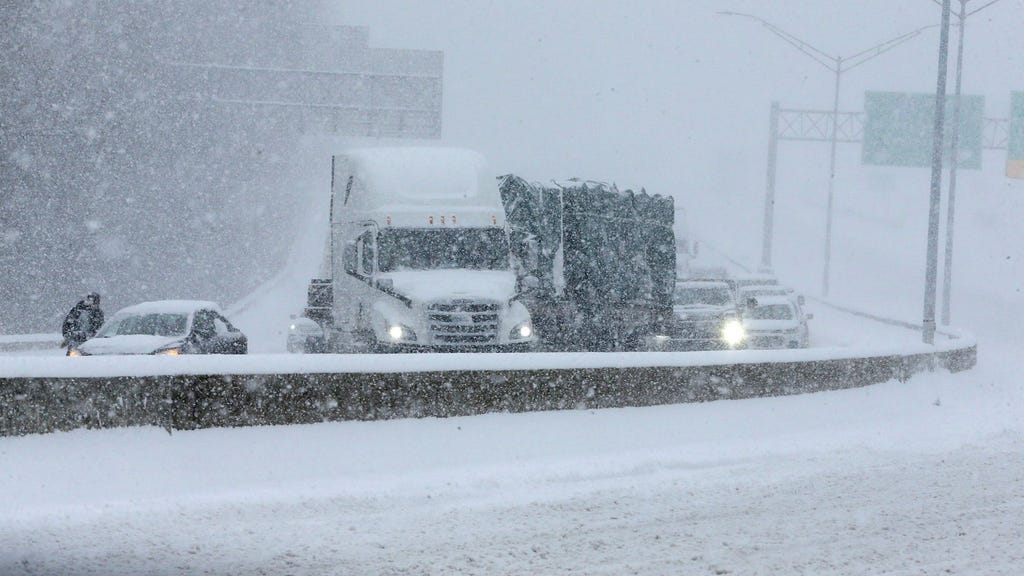A massive winter storm, described as potentially the worst in a decade, is gripping a large swathe of the United States, impacting over 60 million Americans. The storm system is unleashing heavy snowfall, blizzard conditions, and dangerously low temperatures across a wide area, stretching from the West Coast to the Northeast. Schools and businesses have been forced to close, travel has been severely disrupted, and thousands of flights have been cancelled, leaving countless individuals stranded. Authorities are urging residents to stay home, avoid unnecessary travel, and take precautions to stay warm and safe in the face of this extreme weather event. The vast scale and intensity of the storm pose significant challenges for emergency responders and utility companies, as they work tirelessly to restore power outages and provide assistance to those in need.
The storm’s initial impact was felt most acutely in the western states, where heavy snowfall caused widespread power outages and treacherous travel conditions. Mountainous regions have been particularly hard hit, with some areas expecting several feet of snow accumulation. The heavy snow has led to avalanche warnings in several states, further compounding the risks for residents and travelers. As the storm system moves eastward, it is transforming into a potent nor’easter, threatening to bring blizzard conditions and coastal flooding to the densely populated Northeast. The combination of heavy snow, high winds, and freezing temperatures is creating a perilous situation for millions.
The impact on daily life has been significant. Schools across the affected regions have closed, disrupting education for millions of students. Businesses have also been forced to shut down, impacting economic activity and adding to the logistical challenges posed by the storm. The widespread closure of roads and highways has made travel extremely difficult, if not impossible, in many areas. Stranded motorists and truckers are facing challenging conditions as they seek shelter and await improved weather conditions. The storm’s impact on air travel has been equally disruptive, with thousands of flights cancelled or delayed, creating chaos for travelers across the country.
Emergency services are working around the clock to respond to the storm’s impact. First responders are battling challenging conditions to reach those in need of assistance, including stranded motorists and individuals experiencing power outages. Utility crews are working tirelessly to restore power to affected areas, but the widespread nature of the outages and the ongoing hazardous conditions are hampering their efforts. State and local governments have declared states of emergency, mobilizing resources and coordinating emergency response efforts. Shelters have been opened across the affected regions to provide refuge for those displaced by the storm.
The storm’s severity has also raised concerns about the potential for long-term impacts. The heavy snowfall could lead to flooding as temperatures rise and the snow begins to melt. The prolonged power outages pose risks to vulnerable populations, particularly the elderly and those with medical conditions. The economic costs of the storm are expected to be significant, with businesses facing losses due to closures and disruptions to supply chains. The storm serves as a stark reminder of the disruptive power of extreme weather events and the importance of preparedness and resilience in the face of such challenges.
Beyond the immediate impacts of heavy snowfall and blizzard conditions, the storm is also bringing with it the threat of dangerously low temperatures. Wind chill factors are expected to plunge well below zero in many areas, creating life-threatening conditions for those exposed to the elements. Authorities are urging residents to take precautions to protect themselves from the cold, including dressing in layers, staying indoors as much as possible, and checking on vulnerable neighbors and family members. The combination of heavy snow, strong winds, and extreme cold is creating a particularly hazardous situation, requiring vigilance and preparedness from all those in the storm’s path. The widespread disruption and potential for long-term consequences underscore the importance of robust emergency preparedness measures and the need for continued investment in infrastructure resilience to mitigate the impact of future extreme weather events.














